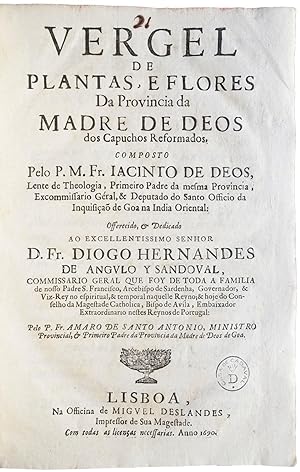Vergel Plantas Flores Provincia Madre by Deus Jacinto O F M (1 results)
Product Type
- All Product Types
- Books (1)
- Magazines & Periodicals
- Comics
- Sheet Music
- Art, Prints & Posters
- Photographs
- Maps
-
Manuscripts &
Paper Collectibles
Condition
- All Conditions
- New
- Used
Binding
- All Bindings
- Hardcover
- Softcover
Collectible Attributes
- First Edition
- Signed
- Dust Jacket
- Seller-Supplied Images
- Not Printed On Demand
Seller Location
Seller Rating
-
Vergel de plantas, e flores da Provincia da Madre de Deos dos Capuchos Reformados.
Published by Lisbon, Na Officina de Miguel Deslandes, 1690., 1690
Seller: Richard C. Ramer Old and Rare Books, New York, NY, U.S.A.
First Edition
Folio (28.1 x 19.8 cm.), contemporary vellum, originally limp (board stiffeners, warped, new endpapers and leather ties recently added), manuscript vertical title on spine, text-block edges sprinkled red. Woodcut vignette on title-page, woodcut initials, head- and tailpieces. Paper flaw in F3 costing a few letters, light marginal dampstaining at end, occasional light spotting. Internally fine; overall in very good condition. Stamp of the Casa de Cadaval in blank margins of title and 2 text pages. Small square printed paper shelf-ticket of same with manuscript notations near upper outer corner of recto of second (older) front free endleaf. (6 ll.), 479 pp. *** FIRST and ONLY complete EDITION of this very rare chronicle of the province of Madre de Deos, Goa, with hundreds of pages on China, Macau, Cambodia and Ceylon. Excerpts, titled Descripção do Imperio da China . were published in Hong Kong, 1878. That edition is also very rare. Vergel de plantas begins with the arrival of Franciscan missionaries in Goa in 1540; it also provides significant material on Cochim, Damão, Chaul and Diu. Chapter 4 is devoted to the activities of Capuchins in China (pp. 115-271), many in Macau, and pp. 149-264 are given over to a "Discriçam do Imperio da China," which includes comments on buildings, navigation, language, police, government, industry, and more. Chapter 5 deals with Malacca and Siam (pp. 272-98), Chapter 6 with Cambodia (pp. 298-354). Chapter 8 has sections on Moçambique (pp. 424-6) and Ceylon (pp. 426-9), and a biography of a Capuchin who was a Kaffir (pp. 439-41). Throughout the volume are extensive comments on churches (including their miraculous images) and on the missionary activity of individual Capuchins in Goa and elsewhere in Asia. (Many of these biographies are 6 to 10 pages long.) While much has been written concerning Jesuit missions in this area, relatively little is known of the Capuchin work which this book details, including at the end a year-by-year chronicle from 1623 to 1679 with the names of the "guardians." Everywhere the Capuchins went they established schools, wrote books in the vernacular of the country, and held public conferences with learned heathen. They found their chief obstacle to be European traders, including Portuguese. Fr. Jacinto made efforts to consult primary source material: "Com grande trabalho descobri o fogo escondido no poço da antiguidade, & obscura caverna do esquecimento por cartorios, & archivos, por informações, & papeis, que alguns particulares curiosos conservarão" (?3v). Some of these documents are transcribed within the text.Born in Macau in 1612, Fr. Jacinto de Deus was a Capuchin who served as provincial and a deputy of the Inquisition in the province of Madre de Deos. He died in Goa in 1681. This work was edited and published posthumously by P. Fr. Amaro de Santo António, provincial of Madre de Deos.During the eighteenth century, Fr. Jacinto was harshly criticized for unnecessarily turning into Portuguese many words that the critics thought had adequate Portuguese equivalents. One critic suggested that the Vergel das plantas should have been entitled Sementeira de vocabulos latinos puerilmente aportuguezados. Innocêncio notes, however, that many of Fr. Jacinto's neologisms had been accepted into common Portuguese usage by the nineteenth century.*** Arouca D19. Innocêncio III, 238-9. Bibliotheca Boxeriana 206. Cordier, Indosinica 1952-3; Sinica 37. Gonçalves 891. Civezza, Saggio di bibliografia geografica storica etnografica Sanfrancescana 185: "Tutto il libro poi è ricco di notizie e documenti interessantissimi delle nostre Missioni nell' Indie Portoghesi, in Cina, in Concicina e nel Tonchino: libro molto raro e ricercatissimo," giving a list of the sections in the description of China (reprinted in Cordier), and noting that his copy, located with much difficulty, lacked the title and the first 11 pages. Barbosa Machado II, 462-3. Bibliografia cronológica da literatura de espiritualidade em Portugal 1760. Figanière 1452. JFB (1994) J1. Palha 2483: "Chronique rare et estimé." Pinto de Mattos (1970) p. 243. Xavier da Cunha, Impressões deslandesianas I, 89-91. Nepomuceno 600. Monteverde 2067. Azevedo-Samodães 3669. Sousa da Câmara 1010. Not in Scholberg. Not in Ameal or Avila Perez. Not in JCB, Portuguese and Brazilian Books. Porbase lists three copies, all in the Biblioteca Nacional de Portugal (one is described as a variant issue, with the final license dated 20 October 1689, as in our copy). Jisc repeats British Library only. NUC: InU, MnU.


